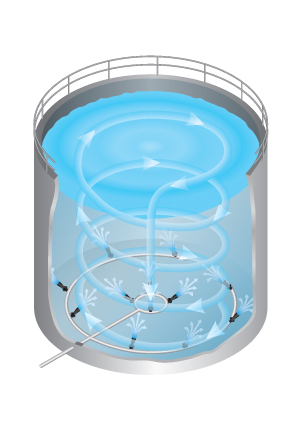Storm tank cleaning systems
Stormwater attenuation tanks fill with excess water from the sewage system in the event of heavy rain. This is to prevent sewage from overloading treatment plants. The contaminated water stored in such tanks is then released back into the sewage system when it can better cope. In this way the water treatment systems of cities are not overwhelmed or literally overflowing every time we have rain.
The water stored in storm tanks contains a large number of biological and non biological contaminants. As the water in such tanks may be stored for several days, considerable sediment will be left behind. Due to the presence of biologically active contaminants there is a potential for foul smelling and toxic residues to form due to bacterial action. Not only do these residues represent health and safety/pollution concerns if left uncleaned, they will eventually impede the effective operation of the storm tank.
The StormBlaster™ system utilises a rotating jet system with powerful cleaning jets to effectively remove residues left behind in the tank after it is emptied.
 Traditional cleaning methods
Traditional cleaning methods
Traditionally, storm tanks are cleaned manually or by eductor systems or tipping buckets.
Eductor systems employ a Venturi nozzle system that recycles rainwater through an eductor, creating a large movement of water under the surface to keep solids in suspension and create a vortex system. These create a swirl as the tank empties which attempts to dislodge residue and debris
Tipping bucket systems are where buckets positioned across the top of the tank are filled and then empty water with force into the tank as per the diagrams below.

Sometimes, manual cleaning is used. This is extremely labour and time intensive and therefore expensive and there are many health and safety issues associated with it.
In many cases, none of these systems provide a sufficiently thorough clean that removes all foul smelling residues.
Watch our short videos below to find out more about the challenges involved in stormwater attenuation tank cleaning and how each of the traditional cleaning methods compare with the StormBlaster™ solution.